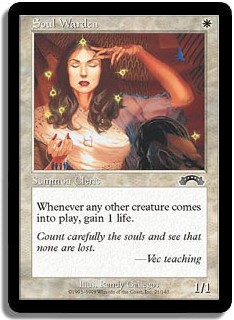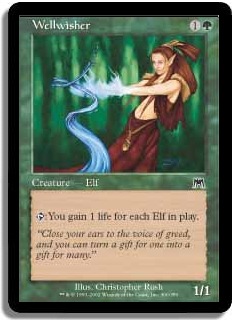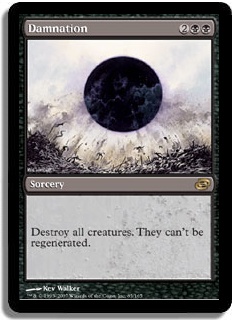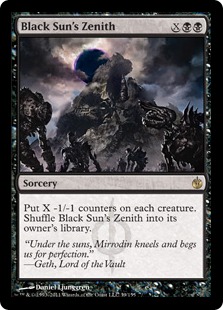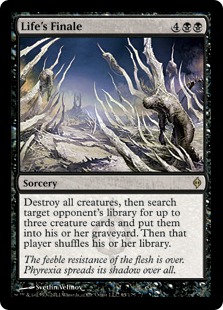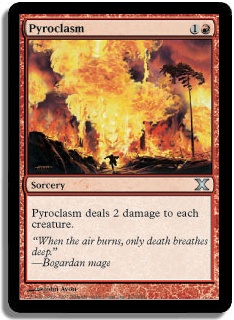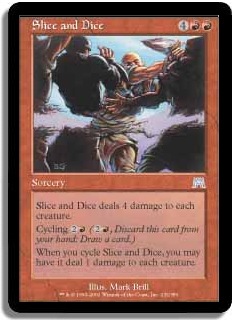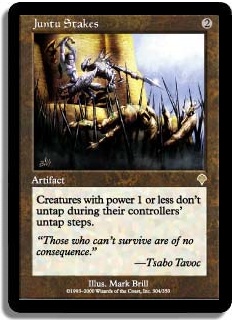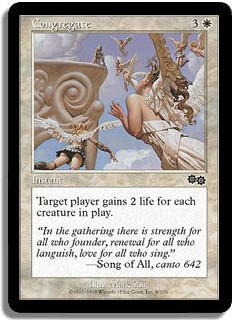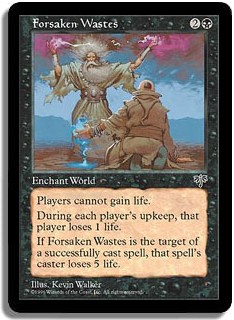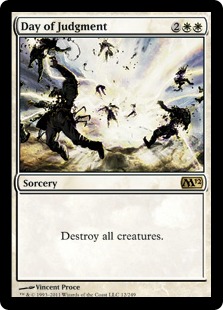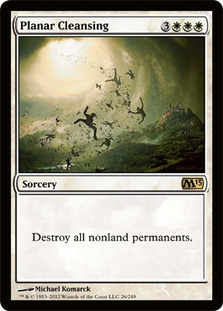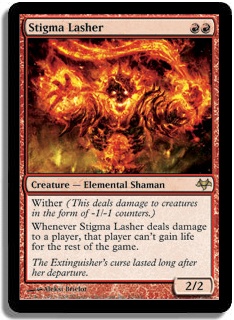Perhaps you are playing Commander tonight. Ray dropped a Soul Warden on turn 1, and now you look over and he has 57 life. When did that happen? Maybe you are playing a normal multiplayer game with twenty life and 60-card decks. Sarah drops Soul’s Attendant, and in a few turns she has doubled her life total. What has happened here? How can you fight against utility creatures like Soul Warden and Wellwisher and engines like Hermit Druid and Goblin Welder?
Today I want to talk about the nature of these guys at the multiplayer table and how to fight them.
Every deck has something that is the lynchpin of its strategy. For some, it’s a simple combo. The key cards in the Pandemonium + Saproling Burst combo deck that deals 21 damage to someone are the two enchantments that win. Sometimes, a deck is built around one card, such as Sneak Attack; Aluren; and Omniscience. This is obviously the key card. Other times, a deck is built around a strategy, but it still has some key cards. An Elf deck may have a bunch of annoying Elves, but something like Priest of Titania is what pushes it. A Sliver deck has Sliver Queen, a Zombie deck has Lord of the Undead bringing dead Zombies back, and more. Every deck has these keystone cards, without which the deck is seriously weakened.
Sometimes, a cheap creature is that foundational card. There is no question that a Goblin Welder; Goblin Lackey; or Hermit Druid can run a deck into a dominating position at the kitchen table in style and alacrity. You have to watch out for these sorts of creatures because they come online before a lot of answers can be dialed up. How much damage can a first-turn Goblin Welder do before your five mana Rout is ready to be played?
In these cases, you want to use your cheap pinpoint removal to end their lives. This is why you play cards like Abrupt Decay; Terminate; Swords to Plowshares; and Murder. I don’t think these are the major issues that people have taking out powerful game changers.
Where the problem arises is in using your limited creature removal to take out utility creatures like the aforementioned Soul Warden and friends. These are adjunct strategies to decks. Do you really want to waste a Murder on an Essence Warden; Disciple of the Vault; or Wellwisher?
And that’s where today’s article comes in. I’ll show you a variety of ways to handle these annoying creatures without losing your ability to handle creatures like Akroma (either one); Consecrated Sphinx; and other beaters.
The First Path: Black’s Withering
Black has a long history of taking creatures down a notch, quite literally, with effects I used to call withering. In my columns, I used to call something like Enfeeblement’s -2/-2 a wither effect. Of course, now I can’t do that since wither was made a keyword.
One of the major challenges in dealing with utility creatures is the simple fact that some are protected from targeted removal. Consider Auriok Champion or a board with an active Mother of Runes. The best way to handle all of these annoying small creatures is to play a mass removal spell that withers everything by a little bit. Make it small enough to keep your guys alive. Infest is a good start. Virtually all annoying utility creatures have a toughness of two or less, so an Infest will clear them all out.
Sometimes, people have raised the power and toughness of utility creatures with Lords beyond the threshold of your wither effects. You typically want something small to prevent your own guys from dying, but I’d pack backup sweeping removal such as Damnation; Black Sun’s Zenith; or Life’s Finale as well just in case this does not work.
One final recommendation: consider Massacre. It’s an Infest that costs one more mana, but if someone has a Plains and you have a Swamp, you can play it for free! That means you can drop it as soon as turn 1 or 2 quite often. It can leave you all of your mana to play something afterwards as well.
The Second Path: Red’s Sweeping Damage
This is clearly a lesser choice than the previous option because of the reasons mentioned above. But if you aren’t playing black or don’t have any Infest or similar cards, this may be the next best choice.
The default card for this strategy is Pyroclasm, which hits all creatures for two damage for an investment of two mana. Not only does it come online early, but it stays and hits a lot later on. It also plays better with your creatures because you can still swing for your normal damage. It has all of the benefits of Infest for clearing out small guys while leaving your bigger ones right out there. There are some trickier versions of these cards which I really enjoy. You can play scalable ones such as Magmaquake or Earthquake, but it is hard to hit flyers (luckily, utility creatures usually are sans flaying).
One of my favorite long-forgotten sweeping removals of this sort is Slice and Dice. It’s a six-mana sorcery that deals just four damage to each creature, which is horrible on the mana, right? (It compares to Magmaquake for four and hits flyers but not planeswalkers). What makes it strong is that you can cycle it at instant speed and draw a card while hitting all creatures for one damage. Not only can you use that for tricks such as dealing that final point of damage to kill a creature in combat, but you can also clear out all of those one-toughness guys while replacing itself with another card. It’s a very good card for some metagames. Is yours one of them?
The Third Path: Hosers
For a while, Opposition decks ruled the roost. It was reprinted in the core set and was in Standard. Masques was slower and very tempo-focused. Cards such as Rising Waters and Rishadan Port were power cards. One of the best commons in Draft was a four-mana Wall: Stinging Barrier. This era saw a lot of cheap creatures churn out an Opposition and then lock down a lot of opposing cards.
Then Invasion saw print, and with it came Juntu Stakes. It locks down creatures with one or less power from untapping. It’s basically the anti Meekstone. A card like Juntu Stakes will fight guys like Mother of Runes; Priest of Titania; and Wellwisher while also handling guys like Goblin Welder. But a Soul Warden is unable to be handled. It doesn’t tap to use its ability. Another example is Aether Flash, which hits all creatures that enter the battlefield for two damage. If you look, you’ll find some more goodies out there to hose these sorts of enemies.
The Fourth Path: Radical Change
Hosers try to kill or end the creatures that are creating these issues. But what if you did something different? Instead of attacking the creature, attack the problem. Is the issue with Wellwisher; Suture Priest; or Soul Warden the fact that they are a 1/1 creature or the fast gaining of life?
Handle the life loss issue. There are a lot of cards out there that will really push a player’s life total, from Congregate to Invincible Hymn. Deal with the life gain problem. Take a look at cards like Everlasting Torment; Forsaken Wastes; and even Havoc Festival. Those will shut down all of these cute life-gaining cards. Now you are in control of the horizontal and the vertical.
The Fifth Path: Wraths
I put a slightly false premise in the beginning. I mentioned that you might have Rout in your hand but not enough time to use it, but I then put down that the main issue is not the Goblin Lackey but the Essence Warden or other utility creature that moves to push a player’s position to a better level. The creatures you don’t want to waste a Path to Exile on. Just play Wraths.
There is a reason that I advocate strongly for the presence of sweeping removal in multiplayer. You need a reset button. You need a do-over. You need a way to clear out all of the crap at the table. I wouldn’t stop at Wrath of God; I’d push into mass removal such as Akroma’s Vengeance that will take out other permanents as well. Austere Command is great at cleaning out the weenies and leaving the big boys out, or hitting artifacts and enchantments only, or whatever. Day of Judgment can come online early, while various specific-need Wraths such as Phyrexian Rebirth; Terminus; Planar Cleansing; and Rout can give you the flexibility to handle other issues at the table.
When Mr. Elf with his Wellwisher and five friends are online, just clean out the board. Maybe he’s gained fourteen life in a few turns, but now we are ending the Elf magic and moving to the real multiplayer game, which is now beginning. I hope he has some bigger bodies and spells because he’s going to need them! Maybe he packs Patriarch’s Bidding in there. You can handle that with more removal! Or a tuck mass removal spell: Hallowed Burial or Terminus. Or an exile mass removal spell: Final Judgment. There are enough Wrath effects out there to fit any metagame and your own deck’s needs.
The Sixth Path: Early Pressure
One of the best things you can do to handle the issues mentioned in today’s article is to play some early guys and put on some major pressure. Don’t attack people who are open or who have a Steel Wall out. Instead, go after enemies with the Wardens et al. Force them to block or take damage. If they take damage, then you have defeated their life gain. If they block, you killed a creature. The large array of strong aggressive creatures in most colors will enable you to force them to play defense and knock their game out of alignment.
I have a secret weapon. This two-drop is so powerful and so nasty that a lot of decks must take care of it immediately. This aggro 2/2 for two mana is so powerful in multiplayer that it can warp a metagame, and it will trounce anybody playing the parlor tricks we’ve mentioned today. What is it? Stigma Lasher. Take a look at it. It has wither, so it will permanently reduce a creature by -2/-2 after it smashes them, eventually getting through a Steel Wall. But where it shines is that when you smash someone, they cannot gain life for the rest of the game.
Imagine that you are playing an Elf deck and on turn 1 you dropped Llanowar Elf and on turn 2 a Wellwisher and an Arbor Elf. You are attacked by a Stigma Lasher; what do you do? Chump it with the Arbor Elf? Trade both it and the Wellwisher for the Lasher? Or do you let it through and not gain any life for the rest of the game? That’s a rough choice it offers early! Stigma Lasher is a nasty two-mana aggressive creature that’s perfect for dealing with annoying small creatures.
I’ve heard a lot of complaints about these small utility creatures in multiplayer recently, so I felt that this article was necessary. Maybe you don’t want to waste your Rend Flesh on a Wellwisher, but you don’t want your foe to gain 28 life in four turns either. So I thought I would give you six ways to handle a Soul Warden or Suture Priest at the kitchen table. None of these involve the use of a 1:1 trade of one removal spell for one creature. I hope that you found some tools and ideas for your next Magic night!
Until later,
Abe Sargent

